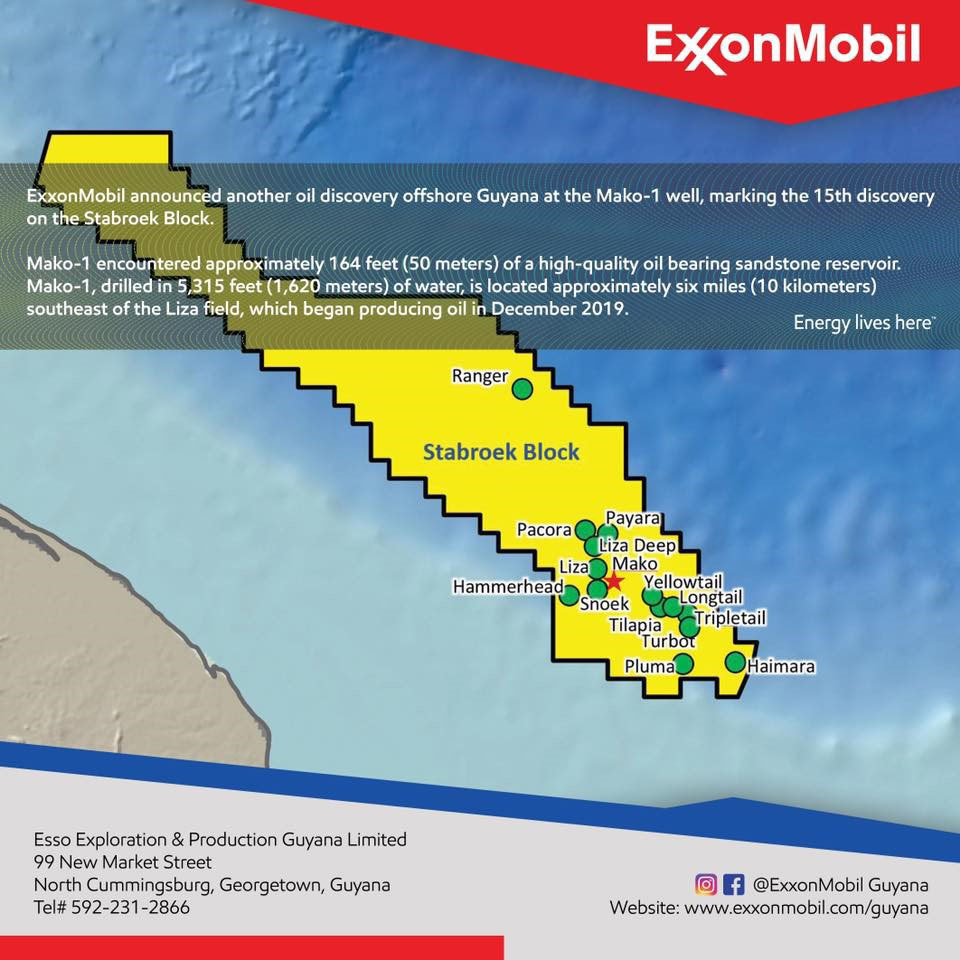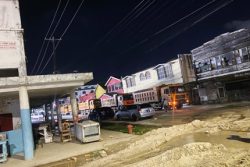ExxonMobil yesterday announced an oil find offshore Guyana at the Mako-1 well southeast of the Liza field, marking its 15th discovery in the Stabroek Block.
In a release, the company said that the discovery adds to the previously announced estimated recoverable resource of more than 6 billion oil-equivalent barrels on the Stabroek Block.
Mako-1 found approximately 164 feet (50 meters) of a high-quality oil bearing sandstone reservoir. Mako-1, drilled in 5,315 feet (1,620 meters) of water, is sited approximately six miles (10 kilometers) southeast of the Liza field, which began producing oil on December 20th.
“New discoveries in this world-class basin have the potential to support additional developments,” said Mike Cousins, Senior Vice-President of exploration and new ventures at ExxonMobil. “Our proprietary full-wave seismic inversion technology continues to help us better define our discovered resource and move rapidly to the development phase.”
Meanwhile, Director of the Department of Energy Dr. Mark Bynoe was quoted as saying in a Ministry of the Presidency statement in wake of the discovery that “This discovery by ExxonMobil and its partners comes on the heels of the start of oil production. The Cooperative Republic of Guyana is experiencing a truly historic moment that has all the ingredients to facilitate a paradigm shift towards sustained economic transformation.”
He added: “The Government of the Cooperative Republic Guyana will continue to conscientiously and assiduously to ensure that petroleum revenues benefit all Guyanese through the ‘Decade of Development’ 2020-2029. The Department of Energy will continue to be at the vanguard of this effort through, inter alia, strengthening its capacity and building out the legislative framework to allow for effective and efficient management of Guyana’s hydrocarbon resources and enhanced value retention.”
The Liza Phase 1 project achieved first oil on December 20th, 2019, and will produce up to 120,000 barrels of oil per day utilizing the Liza Destiny floating production storage and offloading vessel (FPSO). The Liza Well was declared a success in May, 2015.
The Liza Unity FPSO, which will be utilised for the second phase of Liza development and will have a production capacity of 220,000 barrels of oil per day, is under construction and expected to start production by mid-2022.
Pending government approvals and project clearance of a third development, production from the Payara field north of the Liza discoveries could start as early as 2023, reaching an estimated 220,000 barrels of oil per day.
Drilling activities in Guyana continue with four drillships to further explore and evaluate new resources as well as develop the resources within approved projects.
The Stabroek Block is 6.6 million acres (26,800 square kilometers). ExxonMobil affiliate Esso Exploration and Production Guyana Limited is operator and holds 45 per cent interest in the Stabroek Block. Hess Guyana Exploration Ltd. holds 30 per cent interest and CNOOC Petroleum Guyana Limited, a wholly-owned subsidiary of CNOOC Limited, holds 25 per cent interest.
Other ExxonMobil discoveries:
The Liza discovery was announced in May 2015. Liza-1 well was the first significant oil find offshore Guyana. It encountered more than 295 feet (90 meters) of high-quality oil-bearing sandstone reservoirs. It was safely drilled to 17,825 feet (5,433 meters) in 5,719 feet (1,743 meters) of water.
The Payara discovery was announced in January, 2017. Payara was ExxonMobil’s second oil discovery in the Stabroek Block. The Payara-1 well was drilled in a new reservoir, encountering more than 95 feet (29 meters) of high-quality, oil-bearing sandstone reservoirs. It was safely drilled to 18,080 feet (5,512 meters) in 6,660 feet (2,030 meters) of water.
The Snoek discovery was announced in March, 2017. Snoek is ExxonMobil’s third oil discovery in the Stabroek Block. The Snoek-1 well was drilled in a new reservoir, encountering 82 feet (25 meters) of high-quality, oil-bearing sandstone reservoirs. The well was safely drilled to 16,978 feet (5,175 meters) in 5,128 feet (1,563 meters) of water.
The Liza Deep discovery was announced in January, 2017. An appraisal well, Liza-3, identified an additional high quality, deeper reservoir directly below the Liza field, which is estimated to contain between 100-150 million oil equivalent barrels.
The Turbot discovery was announced in October, 2017. Turbot was ExxonMobil’s fifth oil discovery in the Stabroek Block. The Turbot-1 well was drilled in a new reservoir, encountering 75 feet (23 meters) of high-quality, oil-bearing sandstone reservoir. The well was safely drilled to 18,445 feet (5,622 meters) in 5,912 feet (1,802 meters) of water.
The Ranger discovery was announced in January, 2018. Ranger was ExxonMobil’s sixth oil discovery in the Stabroek Block. The Ranger-1 well was drilled in a new reservoir, encountering approximately 230 feet (70 meters) of high-quality, oil-bearing carbonate reservoir. The well was safely drilled to 21,161 feet (6,450 meters) depth in 8,973 feet (2,735 meters) of water. This discovery demonstrated our ultra deepwater and carbonate exploration capabilities and it proved a new play concept for the Stabroek Block.
The Pacora discovery was announced in February, 2018. Pacora was ExxonMobil’s seventh oil discovery in the Stabroek Block. The Pacora-1 well was drilled in a new reservoir, encountering approximately 65 feet (20 meters) of high-quality, oil-bearing sandstone reservoir. The well was safely drilled to 18,363 feet (5,597 meters) depth in 6,781 feet (2,067 meters) of water.
The Longtail discovery was announced in June, 2018. Longtail was ExxonMobil’s eighth oil discovery in the Stabroek Block. The Longtail-1 well was drilled in a new reservoir, encountering approximately 256 feet (78 meters) of high-quality, oil-bearing sandstone reservoir. The well was safely drilled to 18,057 feet (5,504 meters) depth in 6,365 feet (1,940 meters) of water.
The Hammerhead discovery was announced in August, 2018. Hammerhead was ExxonMobil’s ninth oil discovery in the Stabroek Block. The Hammerhead-1 well was drilled in a new reservoir, encountering approximately 197 feet (60 meters) of high-quality, oil-bearing sandstone reservoir. The well was safely drilled to 13,862 feet (4,225 meters) depth in 3,773 feet (1,150 meters) of water.
The Pluma discovery was announced in December, 2018. Pluma was ExxonMobil’s 10th oil discovery in the Stabroek Block. The Pluma-1 well was drilled in a new reservoir, encountering approximately 121 feet (37 meters) of high-quality hydrocarbon-bearing sandstone reservoir. Pluma-1 reached a depth of 16,447 feet (5,013 meters) in 3,340 feet (1,018 meters) of water.
The Tilapia discovery was announced in February, 2019. Tilapia was ExxonMobil’s 11th oil discovery in the Stabroek Block. The Tilapia-1 well was drilled in a new reservoir, encountering approximately 305 feet (93 meters) of high-quality oil-bearing sandstone reservoir and was drilled to a depth of 18,786 feet (5,726 meters) in 5,850 feet (1,783 meters) of water.
The Haimara discovery was announced in February 2019. Haimara was ExxonMobil’s 12th oil discovery in the Stabroek Block. The Haimara-1 well was drilled in a new reservoir, encountering approximately 207 feet (63 meters) of high-quality, gas-condensate bearing sandstone reservoir. The well was drilled to a depth of 18,289 feet (5,575 meters) in 4,590 feet (1,399 meters) of water.
The Yellowtail discovery was announced in April, 2019. Yellowtail was ExxonMobil’s 13th oil discovery in the Stabroek Block. The Yellowtail-1 well was drilled in a new reservoir, encountering approximately 292 feet (89 meters) of high-quality oil bearing sandstone reservoir and was drilled to a depth of 18,445 feet (5,622 meters) in 6,046 feet (1,843 meters) of water.
The Tripletail discovery was announced in September, 2019. Tripletail was ExxonMobil’s 14th oil discovery in the Stabroek Block. The Tripletail-1 well was drilled in a new reservoir, encountering approximately 108 feet (33 meters) of a high-quality oil bearing sandstone reservoir and was drilled in 6,572 feet (2,003 meters) of water.








